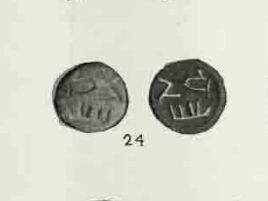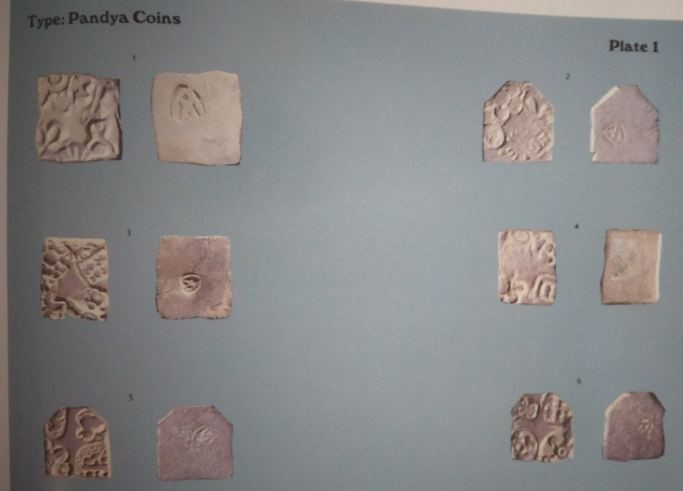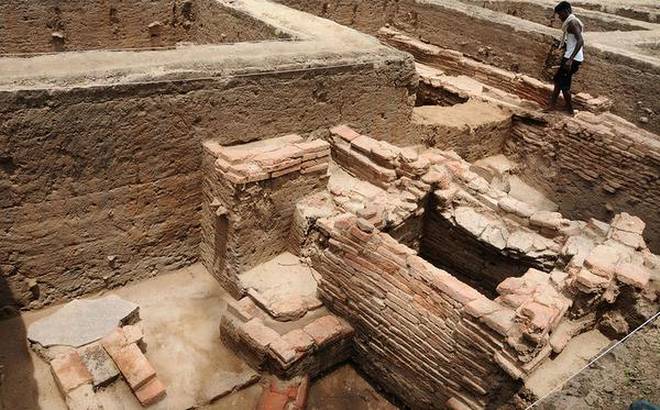The ancient archaeological site at Keezhadi from Tamil Nadu was in the news recently for it’s latest discoveries on the antiquity of the site, early usage Tamil Brahmi script and graffiti symbols which supposedly has links to the script of the earlier Indus valley civilization. Many reports have gone as far to state that the urbanization in ancient Tamil Nadu started at the same time as in Gangetic regions of northern India, around 6th century BCE. They also state that the pre-Vedic Dravidian people of Indus valley civilization migrated southwards and settled in ancient Tamil lands or Tamilakam to give rise to another civilization which was free from the Vedic influences from north, and that Keezhadi finds reflects this pre-Vedic Tamil civilization. How true are these claims? This write up does an analysis of such claims with factual sources.
Usage of early Tamil Brahmi script
First let’s go through the issue regarding Tamil Brahmi script. What is Tamil Brahmi? One of the veteran epigraphist who spent his lifetime on Tamil inscriptions, late Shri Iravatham Mahadevan, states that Tamil Brahmi was regional script adapted from original Brahmi to suit the needs of Tamil [1]
“The early Tamil cave inscriptions are written in a special regional and linguistic variant of the Brahmi script adapted to the needs of Tamil phonetics. This script, now generally referred to as Tamil-Brahmi, is most probably the one named Damili in the Jaina canonical works Samavayanga Sutta and Pannavana Sutta (assigned to the Pre-Christian Era), and as Dravidahpi in the Buddhist work Lalitavistara (probably written in the early centuries A.D.). “
Mahadevan viewed earlier script of Indus valley civilization as representing Dravidian language, but even he had to admit that Tamil Brahmi is but a modified version of original Brahmi which was used in other parts of the Indian subcontinent. It only means Brahmi script was originally used to write dialects of Prakrit language, which were evolved from Old Vedic Sanskrit or it’s related dialects, which was also the popular language from regions of Afghanistan in north to Deccan in south during the early historic period.
The fact that Prakrit was the original language of Brahmi is further supported by occurrence of many Prakrit inscriptions from early Sangam age Tamilakam. It could only point towards northern origins of Brahmi from Prakrit speaking areas. Archaeologist K. Rajan in his book has written the following [2].
“There are several names of north Indian origin, which are in Prakrit proper. A few are in hybrid form too. The Prakrit names can be recognized by the occurrence of non-Tamil graphemes (aspirants. soft letters, and sibilants) and the genitive case endings like śa, sa, ha. ya. There are several names in pure Tamil like campaṉ , vaḷikaṉ , kannaṉ , antavaṉ n, cuḷantai, māttaṉ , pākaṉ, in Prakrit like nikama, and in Tamilized Pralkrit like kuviraṉ , silikaṉ and makatai. There are certain names like ātaṉ-asaṭaṉ and periyaṉ -sātaṉ , in which, one segment is in Tamil and another segment is in Prakrit or in Tamilized Prakrit. Another interesting feature is that certain names are written differently. For instance, the Prakrit names sāta and tisa are Tamilized by adding alveolar ṉ at the end making the word as sātaṉ and tissaṉ respectively. In another instance. the initial sa in the word sātaṉ is converted into Tamil ca. Likewise, the name tisa is written as tīssaṉ/tissaṉ as well as tissan (the alveolar ending ṉ is replaced with dental n).The writing in both ways like cātaṉ or sātaṉ, clearly suggests that the residents of Kodumanal were familiar with both the languages. ”
In fact multiple sites dating back to early Sangam age in Tamil Nadu has yielded inscribed Prakrit words. As per K. Rajan, the Prakrit words occurs from earliest layers in Tamil Nadu, going back to 6th century BCE [3]
“Thus, the influence of Prakrit-speaking at lexical and structural levels needs to be studied very closely. However, there is not much room for such structural analysis in Kodumanal inscribed potsherds as 99% of them are very short and mostly carry personal names. We hardly get any evidence of Prakritized Tamil, probably unwarranted in Tamil speaking area. The occurrence of Prakrit names from the lowermost layers of the habitation cuttings suggest that the adaptation process might have taken place well before 6th century BCE. “
Also, supposedly one of the earliest discovered Tamil Brahmi inscription from Tamil Nadu reads as ‘vayra’ which itself is a loan from Sanskrit or Prakrit vajra. So this proves that Tamil Brahmi had Prakrit loans since earliest period [4]
Another thing is that as per the excavation reports, the early Tamil Brahmi inscriptions from Keezhadi itself shows Tamilized loans from Prakrit or Sanskrit such as the name Kuviraṉ. It is ultimately from Sanskrit name Kubera, who is the ruler of Yakshas or nature spirits. [5]
From all these evidences, we can say that early Prakrit loans into Tamil inscriptions from earliest periods shows a crystal clear link with north, and probably that Prakrit loans came from north to south along with the Brahmi script. So in nutshell, the discovery of early Tamil Brahmi inscriptions only pushes back the antiquity of the original northern Brahmi as well.
The link between Indus script symbols and graffities discovered from southern sites.
Now we move on the Graffiti-Indus link. The finds of Indus script-like graffities from Tamil Nadu is nothing new. Over the years, there have been various reports of these Indus script-like finds. However none of them have been verified properly because the graffiti signs occur here and there, that too mostly in isolated cases without any proper sequence like we see in a proper writing system. These signs do occur along with Brahmi letters sometimes, but probably these were trademarks or other sort of marks representing regional marks, industry, clan or tribe etc. To claim that it represents a developed writing system like Indus script is too much, as we don’t have any proper inscriptions in such graffities apart from isolated occurrences. Such graffiti symbols also occurs in iron age cultures of north India. For example as seen in this seal from the ancient city of Vaishali in Bihar [6].
 Figure.1 The seal from ancient city of Vaishali with graffiti symbols resembling Indus script signs.
Figure.1 The seal from ancient city of Vaishali with graffiti symbols resembling Indus script signs.This seal is dated much later than Indus valley civilization. It was commented upon even by Iravatham Mahadevan, who usually endorsed Dravidian authorship of Indus valley civilization, as representing Indus script-like signs [7].
We do not know the exact significance of such symbols. It is true that some symbols does have resemblance to the Indus signs, and even if such graffiti symbols found from southern India indeed derive from Indus script, it doesn’t mean that Indus language was Dravidian. After all the seal from Vaishali is obviously from the era when the region was part of Vedic culture (archaeologists dated it to Mauryan era at the earliest, while Mahadevan comments that it is at least from 1100 BCE). Hence, we can also view that such graffiti symbols came from north to south via historical expansion of the Vedic culture into southern India which had it’s origins from Indus valley, if we identify Indus valley civilization as Vedic or even ancestral to the Vedic culture! Thus the assumption that the Indus-like symbols discovered from southern India indicates a Dravidian migration from Indus valley to southern India is entirely based on the preconceived notion that Indus valley civilization was Dravidian.
A non-Vedic civilization in early Tamilakam?
Finally we come to the most important issue. Since the Keezhadi finds, the Dravidianists have been claiming that Keezhadi represents an independent pre-Vedic secular Tamil civilization which was free of Vedic influences from north.
From the Prakrit loans highlighted previously, it is clear that Keezhadi, like other ancient sites of Tamilakam, had links with northern India since it’s earliest period and they were not part of any isolated separate pre-Vedic Tamil civilization.
True, the findings from Keezhadi would push back the date of urbanism in Tamilakam back to 6th century BCE. But to say that it was contemporary to Gangetic urbanization is not entirely correct.
 Figure 2. Punch-marked coins of Pandyan kingdom.
Figure 2. Punch-marked coins of Pandyan kingdom.By 600 BCE many urban Vedic Janapadas with grand cities were already established in Gangetic region as well as in Deccan. These Janapadas also minted their own punch-marked coins. In fact we also find early Tamil Pandyan kingdom minting the same type of coins with their royal fish symbol on reverse [8]
This only means that proper kingdoms & currency system was established in southern India during the time of Vedic Janapadas with the influences from north.
Thus, the early Tamil kingdoms were part of one unified civilization which included northern Janapadas as well, and the Tamil kingdoms & ancient sites like Keezhadi were not part of any separate pre-Vedic civilization like Dravidianists wants them to be.
Also it is plain wrong to state that urbanism in Tamilakam occurred same time as in Gangetic region. Urbanism in Gangetic region dates back to ‘proto-urban’ Pianted Grey Ware or PGW cultural phase, beyond 1000 BCE and well beyond 6th century BCE dates from Keezhadi. Some PGW sites also overlaps with late Indus culture. As noted historian Upinder Singh has written in her book [9]:
“The dates of the PGW culture range from c.1100 to c 500/400 BCE, and the sites in the north-west are probably earlier than those in the Ganga valley Given as wide geographical distribution and chronological range, it is not surprising that there are regional variations both in the pottery as well as in associated remains. In the archaeological sequence of the Ganga valley, the PGW phase is followed by the Northern Black Polished Ware (NBPW) phase, the beginning or which goes back to c, 700 BCE at Sringaverapura.The evidence from various PGW sites suggests a proto-urban phase. “
Important evidence of the PGW material culture is available from excavated slits such as Hastinapur, Alamgirpur, Ahichchatra, Allahpur, Mathura, Kampil, Noh, Jodhpura, Bhagwanpura, Jakhera, Kaushambi, and Shravasti. PGW occurs in four kinds of stratigraphic contexts. At some sites (e.g. Rupar and Sangho! in Punjab, Daulatpur in Haryana, and Alamgirpur and Hulas in western UP), it is preceded by a late Harappan level, with an intervening break in occupation. At other sites (e.g. Dadhert, Katpalon. and Nagar in the Punjab and Bhagwanpura in Haryana), there is an overlap between the PGW and late Harappan phase.”
In fact Keezhadi is just one site showing early signs of urbanism in Tamilakam, while most other ancient sites in ancient Tamilakam were overwhelmingly in non-urban megalithic phase during the iron age until urbanism came in during later centuries. In Gangetic zone we have signs of urbanism or proto-urbanism from multiple sites which later evolved into grand cities as stated above.
The urbanization of Gangetic region was a gradual process, tracing the roots to iron age PGW culture which itself overlapped with late Indus culture. It is certainly older than any urban site from Tamilakam discovered so far. So it is not correct to claim that process of urbanism in early Tamilakam was contemporary with that of north.
Vedic civilization unified north & south India
Finally, I quote the words of one of the greatest south Indian historian Shri KAN Sastri. According to him the Vedic ‘Aryanization’ process of southern India started with early phase from around 1000 BCE onwards [10]
“The Aryanization of the South was no doubt a slow process spread over several centuries. Beginning probably about 1000 BC, it had reached its completion before the time of Katyayana, the grammarian of the fourth century BC, who mentions the names of the Tamil countries of the extreme South. “
During 1000 BCE most parts of Tamilakam was in megalithic phase. While we have no clue about the language or religion of these iron age megalithic people, from their association with punch-marked coins & prevalence of megalithic culture even into later centuries (by then Tamil kingdoms already followed Vedic culture), we can probably infer that it could indeed have been associated with expansion of Vedic culture from north. The proper urban civilization in Tamilakam gradually evolved from megalithic phase by later centuries BCE & it didn’t form any separate civilization from north. Once the expansion of Vedic culture into south happened, both north & south India had one unified Vedic civilization since earliest attested historic era.
All likely the Vedic cultural expansions from out of Aryavarta (regions of northern India which was the land of Vedic Aryans) during late Vedic era onwards also included movement of people as well. Hence, vast majority of the modern speakers of Dravidian linguistic group, including the Tamils, also share the heritage & ancestry of ancient Vedic civilization.
References
[1] Recent Discoveries of Jaina Cave Inscriptions in Tamilnadu by Iravatham Mahadevan
[2] Early Writing System: A Journey from Graffiti to Brahmi by K. Rajan p.421.
[3] Ibid, p.422.
[4] Palani excavation triggers fresh debate – The Hinduhttps://www.thehindu.com/news/national/tamil-nadu/palani-excavation-triggers-fresh-debate/article2408091.ece
[5] Keeladi An Urban Settlement Of Sangam Age by TN Archeological Society p.14
[6] Vaisali excavations, 1958-1962, by B. P. Sinha, and Sita Ram Roy Plate XXX, seal 24.
[7] Iravatham Mahadevanas cited in The Lost River: On The Trail of the Sarasvati, by Michel Danino p.218
[8] Sangam Age Tamil Coins by R.Krishnamurthy Plate 1, 1-6.
[9] A History of Ancient and Early Medieval India: From the Stone Age to the 12th Century by Upinder Singh p.246. [10] A History of South India: From Prehistoric Times to the Fall of Vijayanagar by KAN Sastri p.17.
Featured Image: The Hindu





